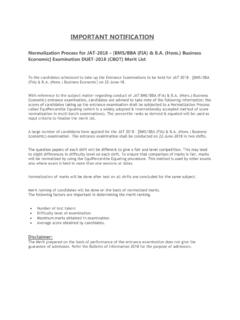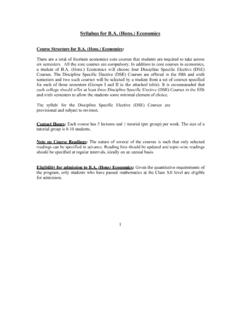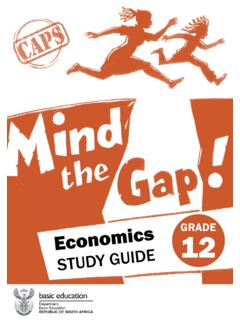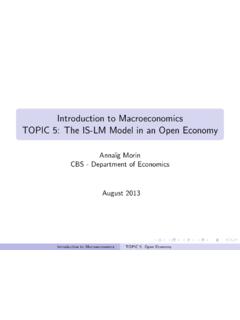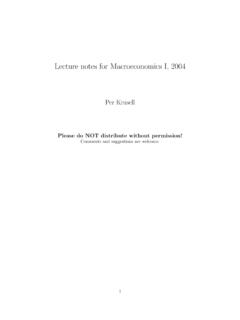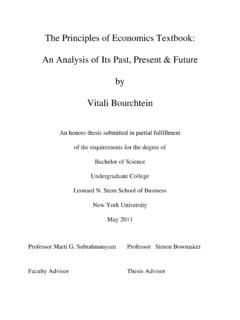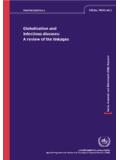Transcription of B.A. PROGRAMME - Delhi University
1 1 PROGRAMME DISCIPLINE COURSE ECONOMICS COURSE CONTENTS (Effective from the Academic Year 2011-2012 onwards) DEPARTMENT OF ECONOMICS University OF Delhi Delhi 2 Syllabus for PROGRAMME - Economics University of Delhi Course Structure for PROGRAMME Economics: There are a total of six Economics courses that students are required to take across six semesters as follows: Semester I Semester II 01: Principles of Microeconomics - I 02: Principles of Microeconomics - II Semester III Semester IV 03: Principles of macroeconomics - I 04: Principles of macroeconomics - II Semester V Semester VI 05: Economic Development and Policy in India I 06: Economic Development and Policy in India - II Contact Hours: Each course has 4 lectures and 1 tutorial (per group) per fortnight.
2 Assessment: Each course carries 100 marks of which the end-semester examination is of 75 marks and internal assessment is worth 25 marks. Note on Course Readings: Reading lists will be updated and topic-wise readings will be discussed in regular meetings organised by the Department of Economics, Delhi School of Economics, for all college teachers of the University of Delhi associated with teaching PROGRAMME - Economics courses. 3 Course 01: Principles of Microeconomics I Course Description This course intends to expose the student to the basic principles in Microeconomic Theory and illustrate with applications.
3 Course Outline 1. Introduction a. Problem of scarcity and choice: scarcity, choice and opportunity cost; production possibility frontier; economic systems. b. Demand and supply: law of demand, determinants of demand, shifts of demand versus movements along a demand curve, market demand, law of supply, determinants of supply, shifts of supply versus movements along a supply curve, market supply, market equilibrium. c. Applications of demand and supply: price rationing, price floors, consumer surplus, producer surplus. d. Elasticity: price elasticity of demand, calculating elasticity, determinants of price elasticity, other elasticities.
4 2. Consumer Theory Budget constraint, concept of utility, diminishing marginal utility, Diamond-water paradox, income and substitution effects; consumer choice: indifference curves, derivation of demand curve from indifference curve and budget constraint. 3. Production and Costs a. Production: behaviour of profit maximising firms, production process, production functions, law of variable proportions, choice of technology, isoquant and isocost lines, cost minimizing equlibrium condition. b. Costs: costs in the short run, costs in the long run, revenue and profit maximizations, minimizing losses, short run industry supply curve, economies and diseconomies of scale, long run adjustments.
5 4. Perfect Competition a. Assumptions: theory of a firm under perfect competition, demand and revenue; equilibrium of the firm in the short run and long run; long run industry supply curve: increasing, decreasing and constant cost industries. b. Welfare: allocative efficiency under perfect competition. Readings: Case, Karl E. & Ray C. Fair, Principles of Economics, Pearson Education, Inc., 8th edition, 2007. 4 Course 02: Principles of Microeconomics - II Course Description This is a sequel to Principles of Microeconomics - I covered in the first semester.
6 The objective of the course is the same as in Principles of Microeconomics I. Course Outline 1. Market Structures a. Theory of a Monopoly Firm Concept of imperfect competition; short run and long run price and output decisions of a monopoly firm; concept of a supply curve under monopoly; comparison of perfect competition and monopoly, social cost of monopoly, price discrimination; remedies for monopoly: Antitrust laws, natural monopoly. b. Imperfect Competition Monopolistic competition: Assumptions, SR & LR price and output determinations under monopolistic competition, economic efficiency and resource allocation; oligopoly: assumptions, oligopoly models, game theory, contestable markets, role of government.
7 2. Consumer and Producer Theory a. Consumer and Producer Theory in Action Externalities, marginal cost pricing, internalising externalities, public goods; imperfect information: adverse selection, moral hazard, social choice, government inefficiency. b. Markets and Market Failure Market adjustment to changes in demand, efficiency of perfect competition; sources of market failure: imperfect markets, public goods, externalities, imperfect information; evaluating the market mechanism. 3. Income Distribution and Factor pricing Input markets: demand for inputs; labour markets, land markets, profit maximisation condition in input markets, input demand curves, distribution of Income.
8 4. International Trade Absolute advantage, comparative advantage, terms of trade, sources of comparative advantage, trade barriers, free trade/ protectionism. Readings: Case, Karl E. & Ray C. Fair, Principles of Economics, Pearson Education, Inc., 8th edition, 2007. 5 Course 03: Principles of macroeconomics - I Course Description This course introduces students to the basic concepts in macroeconomics . macroeconomics deals with the aggregate economy.
9 In this course the students are introduced to the definition, measurement of the macroeconomic variables like GDP, consumption, savings, investment and balance of payments. The course also discusses various theories of determining GDP in the short run. Course Outline 1. Introduction What is macroeconomics ? Macroeconomic issues in an economy. 2. National Income Accounting Concepts of GDP and National Income; measurement of national income and related aggregates; nominal and real income; limitations of the GDP concept. 3. Determination of GDP Actual and potential GDP; aggregate expenditure; consumption function; investment function; equilibrium GDP; concepts of MPS, APS, MPC, APC; autonomous expenditure; Concept of multiplier.
10 4. National Income Determination in an Open Economy with Government Fiscal Policy: impact of changes in government expenditure and taxes; net exports function; net exports and equilibrium national income. 5. Money in a Modern Economy Concept of money in a modern economy; monetary aggregates; demand for money; quantity theory of money; liquidity preference and rate of interest; money supply and credit creation; monetary policy. Readings: 1. Case, Karl E. & Ray C. Fair, Principles of Economics, Pearson Education, Inc., 8th edition, 2007. 2.





